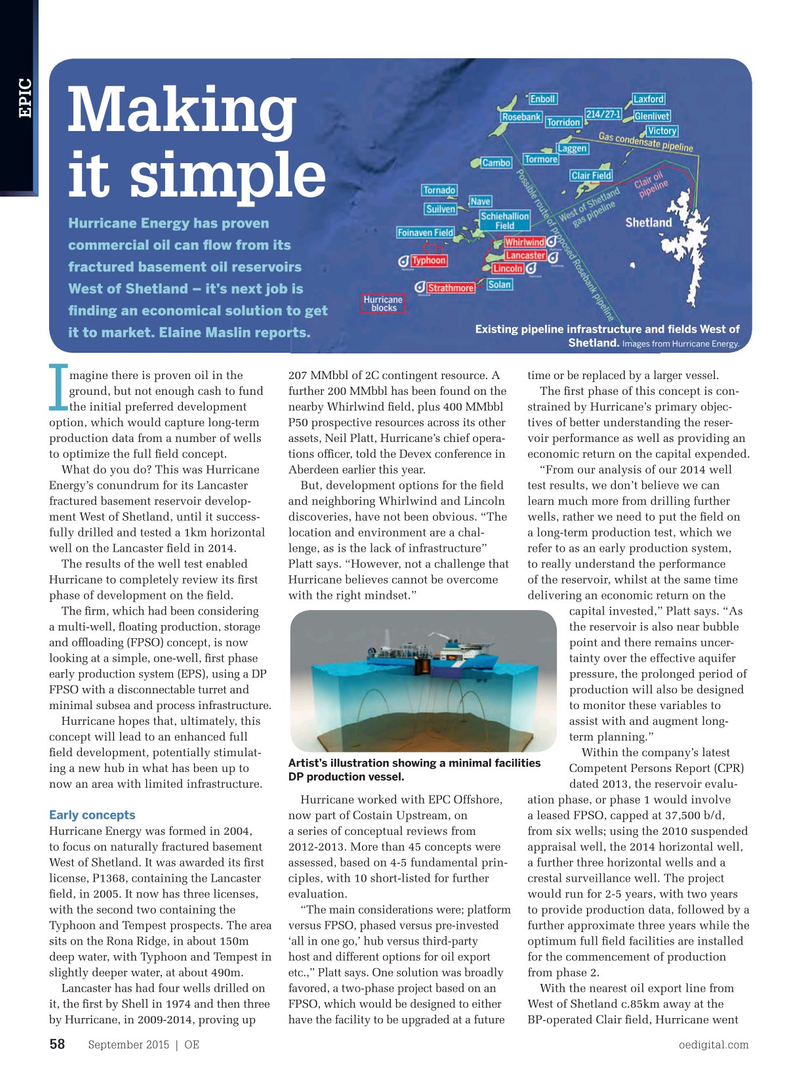
Page 56: of Offshore Engineer Magazine (Sep/Oct 2015)
Read this page in Pdf, Flash or Html5 edition of Sep/Oct 2015 Offshore Engineer Magazine
EPIC
Making it simple
Hurricane Energy has proven commercial oil can ? ow from its fractured basement oil reservoirs
West of Shetland – it’s next job is ? nding an economical solution to get
Existing pipeline infrastructure and ? elds West of it to market. Elaine Maslin reports.
Shetland. Images from Hurricane Energy.
magine there is proven oil in the 207 MMbbl of 2C contingent resource. A time or be replaced by a larger vessel. ground, but not enough cash to fund further 200 MMbbl has been found on the The ? rst phase of this concept is con-
I the initial preferred development nearby Whirlwind ? eld, plus 400 MMbbl strained by Hurricane’s primary objec- option, which would capture long-term P50 prospective resources across its other tives of better understanding the reser- production data from a number of wells assets, Neil Platt, Hurricane’s chief opera- voir performance as well as providing an to optimize the full ? eld concept. tions of? cer, told the Devex conference in economic return on the capital expended.
What do you do? This was Hurricane Aberdeen earlier this year. “From our analysis of our 2014 well
Energy’s conundrum for its Lancaster But, development options for the ? eld test results, we don’t believe we can fractured basement reservoir develop- and neighboring Whirlwind and Lincoln learn much more from drilling further ment West of Shetland, until it success- discoveries, have not been obvious. “The wells, rather we need to put the ? eld on fully drilled and tested a 1km horizontal location and environment are a chal- a long-term production test, which we well on the Lancaster ? eld in 2014. lenge, as is the lack of infrastructure” refer to as an early production system,
The results of the well test enabled Platt says. “However, not a challenge that to really understand the performance
Hurricane to completely review its ? rst Hurricane believes cannot be overcome of the reservoir, whilst at the same time phase of development on the ? eld. with the right mindset.” delivering an economic return on the
The ? rm, which had been considering capital invested,” Platt says. “As a multi-well, ? oating production, storage the reservoir is also near bubble and of? oading (FPSO) concept, is now point and there remains uncer- looking at a simple, one-well, ? rst phase tainty over the effective aquifer early production system (EPS), using a DP pressure, the prolonged period of
FPSO with a disconnectable turret and production will also be designed minimal subsea and process infrastructure. to monitor these variables to
Hurricane hopes that, ultimately, this assist with and augment long- concept will lead to an enhanced full term planning.” ? eld development, potentially stimulat- Within the company’s latest
Artist’s illustration showing a minimal facilities ing a new hub in what has been up to Competent Persons Report (CPR)
DP production vessel.
now an area with limited infrastructure. dated 2013, the reservoir evalu-
Hurricane worked with EPC Offshore, ation phase, or phase 1 would involve
Early concepts now part of Costain Upstream, on a leased FPSO, capped at 37,500 b/d,
Hurricane Energy was formed in 2004, a series of conceptual reviews from from six wells; using the 2010 suspended to focus on naturally fractured basement 2012-2013. More than 45 concepts were appraisal well, the 2014 horizontal well,
West of Shetland. It was awarded its ? rst assessed, based on 4-5 fundamental prin- a further three horizontal wells and a license, P1368, containing the Lancaster ciples, with 10 short-listed for further crestal surveillance well. The project ? eld, in 2005. It now has three licenses, evaluation. would run for 2-5 years, with two years “The main considerations were; platform with the second two containing the to provide production data, followed by a versus FPSO, phased versus pre-invested
Typhoon and Tempest prospects. The area further approximate three years while the ‘all in one go,’ hub versus third-party sits on the Rona Ridge, in about 150m optimum full ? eld facilities are installed host and different options for oil export deep water, with Typhoon and Tempest in for the commencement of production etc.,” Platt says. One solution was broadly slightly deeper water, at about 490m. from phase 2. favored, a two-phase project based on an
Lancaster has had four wells drilled on With the nearest oil export line from
FPSO, which would be designed to either it, the ? rst by Shell in 1974 and then three West of Shetland c.85km away at the have the facility to be upgraded at a future by Hurricane, in 2009-2014, proving up BP-operated Clair ? eld, Hurricane went
September 2015 | OE oedigital.com 58 058-OE0915_EPIC2_Hurricane.indd 58 8/20/15 10:48 AM

 55
55

 57
57